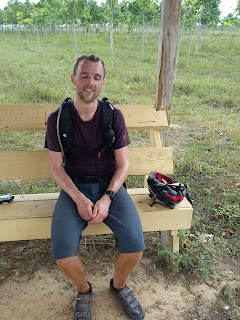Generally, the experience of any given road by car and by bike are very different. The range of these experiences will obviously differ depending on the road, but at the least you might imagine that in one, a softly humming engine exerts itself whilst you nod sleepily to its purr; in the other, the sweat slowly beads on your brow as the wind blows against your knees and you puff a little with gentle exertion. This distinction is the mild version, but either way we’ve come to learn that a serious filter is needed to advice given by drivers of cars about what a road might be like to ride by bike.
For example (genuine experiences):
‘there is a shop just round the corner’ = ride on 15km
‘it kind of rolls up and down a bit’ = there are some mega climbs coming
‘the road is a bit rough at times’ = brace yourself, you’re wrists are about to develop carpel tunnel syndrome (Lizzie hasn’t felt her little finger since Mexico)
But the filter that we need to apply isn’t simply one of magnifying whatever caution we have been given, we also need to adjust the other way. People simply struggle to believe that we’ve cycled the 20km from the previous town, let alone intend to cycle across their entire country (and some), and so often quite achievable challenges are declared as ‘IMPOSSIBLE!’. The combination of these two distortions mean that whilst we regularly ask for advice about the roads (most importantly: ‘esta asfalto!?’) we then have to triangulate this against our own random assessment of how ambitious/lazy/melodramatic our interlocutor appears. Of late, this assessment has been letting us down.
We were told that the road from Fray Bartolome de las casas to Pajal was completely unrideable; and so we shrugged, hopped on our bikes and gave it a go. Some might call this arrogance but honestly, if we stopped every time someone said that, we’d hardly ride any of this journey. Hours of pushing our less than compliant loads (millions of man hours have been invested in making bikes ideal riding machines, I’m not sure any have been sunk into the less glamerous ergonomics of pushing) up a rock strewn 14% gradient, we realised that our current finger in the air, triangulating activity doesn’t leave space for the answer to ever be ‘Oh, okay, let’s get a bus then’. Five hours into this ordeal, after pondering the difference between something being character building and just bloody hard work, and off the back of a timely little outpouring from Lizzie to let Ali know just how tired she was, the second truck of the day shuddered to a halt just in front of us and a couple of chicken laden ladies descended. We saw our moment and in an instant we were up, bikes, panniers and all, bumping around for the next hour in the back of a cattle wagon to cover the remaining 20km. We consolled our moment of weakness with the fact that we would never have been able to cover this distance via the Sisyphus-esque torture through which we were putting ourselves.
In part, we share this story to contrast it with two days later when we finally heeded the warnings of locals about the quality of the road, and keen to maintain this expedition as a bike ride with a heavy load, rather than a hike with an obtuse load, we took a bus for the 20 something Km for which we’d recieved a very similar warning to our previous boulder strewn Everest - and didn’t first feel the need to discover this for ourselves. The bus wound down and down to a river crossing where we insisted on dismounting to the utter horror of the very friendly conductor. ‘No, you can’t, it’s such a steep hill. No you can’t, it is asphalt, but it’s not possible...but, but, let us take you to the town, but, but….. why!!??’.
Needless to say, we got off the bus and crawled hour after hour up the 1,000 metres; this time, delighting in the pleasure of the smoooooth asphalt and feeling like we were doing what we have come to Guatelmala for.
















